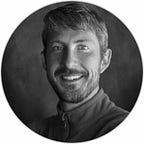Stop Dribbbling, Get a Design Education at Costco
A Special Hell for Designers Like Me (Part 4)
Paul was a commercial artist in Chicago in the era before computers, back when being a designer still involved ink-stained fingers and drawing pictures. The unpredictable tornado of life spun him out of the Mad Men scene and hurled him into a second career in law enforcement. Eventually the twister sucked him out of his police car and dropped him at Costco.
Costco is where our paths crossed. I was a zero who desperately wanted my first design job. Paul was the most interesting man in the world. Together we were the inventory auditors at a retail warehouse club in a Denver suburb.
Before sunrise my design mentor and I would walk the cavernous aisles with our clipboards counting things. It sounds incredibly dull, but think about what an amazing opportunity that is for a design student.
I had unlimited access to thousands of products that contained the fingerprints of designers from all over the world. By pure coincidence, I was able to study this design archive daily with the 1-on-1 guidance of a veteran of the design industry.
When we weren’t counting cans of corn, Paul would pick a product off the shelf and quiz me. What were the merits of the design? Why did some packaging feel premium and others generic? Was this an artifact of artistic integrity, or the thoughtless output of a designer drone? He gave me a second education.
Forget the design magazines, the award shows, the logo books, and the compilations of design porn. That’s not real. If you want to study design get a job at a big box store. Work the night shift when it is quiet and your time isn’t scrutinized by an ambitious manager. Spend your time studying the products. As consumers we buzz past this stuff but rarely meditate on it. But this is the where a real understanding of design is formed, not on Dribbble.
Paul and I loved to study logos. Occasionally we would find a collection of logos all grouped together on a box, NASCAR-style. We debated the merits of each mark as if it was an entry in a competition where we were respected judges. After careful debate we awarded the logo with the industry’s most prestigious honor. Congratulations, some nobody warehouse worker somewhere thinks your logo is hot snot.
When we weren’t on the floor counting product, Paul and I were doing paperwork. Paul used every trivial form as a chance to practice his immaculate penmanship.
The contrast between terribly designed forms and his beautiful handwriting and carefully chosen words was stunning. When a worker completes a menial task with craftsmanship like this, the dissonance is uncomfortable. Paul loved to toy with this social norm. When he handed his manager routine inventory correction papers, they were beautiful.
He was daring his boss to scold him for caring. He wanted them to criticize him for putting too much effort into the common tasks.
If you are asked to do a sub-human job and you pour your humanity into it, your boss is caught in a lie. He is forced to acknowledge both the dehumanizing request he is making as well as the poetry represented in your work. Either that, or you get fired for being obstinate. Paul walked that fine line and I watched in awe.
Paul knew something I didn’t. It doesn’t matter where you work, Costco, Pentagram, or the police. Every task you complete has the potential to be a creative contribution that makes things better. Design isn’t something a handful of specialists do in a pristine vacuum isolated from the commoners. We can choose to either do our work with integrity, or we can take shortcuts.
In hindsight it is easy to recognize how lucky I was to have a design mentor before I even had a design job. Of course at the time, I hated my job. Costco seemed world’s away from my design ambitions. When I finally landed a graphic design job I was ecstatic. I worked my last two weeks, cut the going-away cake, and said goodbye to Paul. Little did I know the zombie apocalypse I was about to enter…
